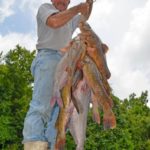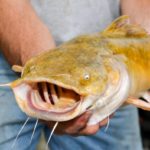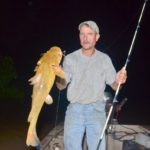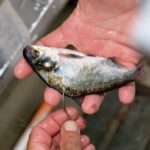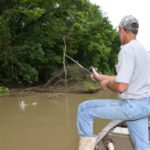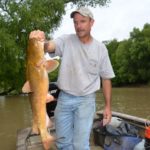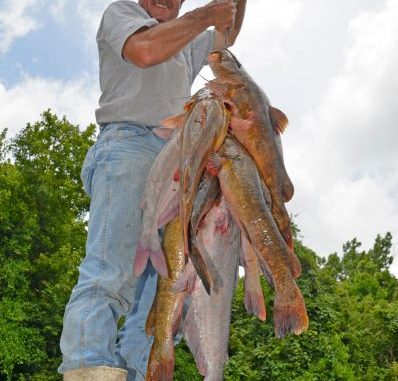
This swamper spends as much time as possible targeting one of the coolest cats in the water — goujon. Follow his lead, and you’re sure to add a lot of meat to your freezer.
All Johnny Broussard’s friends describe him as a man of the swamp.
“I met him in the swamp,” his good friend David Meyers said. “That’s because that’s where he always is.”
Actually, he isn’t always in the swamp. The slender, athletic, square-jawed Cajun with the mischievous twinkle in his blue eyes owns and operates Johnny’s Custom Paint in Broussard.
He does custom paint and body work on motorcycles — what a hot rod shop would do, except on bikes.
“I work long days in the spring and summer — 12-hour days,” Broussard said. “A lot of what I do is after work. That’s why I fish a lot at night.”
Broussard first caught my attention on, of all places, a boat in blue water 40 miles into the Gulf of Mexico. After hauling several snappers over the rail, he quietly mentioned that what he really likes to do is fish for goujon in the Atchafalaya Basin with a rod and reel.
Now, I like goujon.
They appeal to the fisherman part of me because they grow big, often reaching weights of more than 50 pounds. The IGFA world record stands at 123 pounds.
They appeal to my culinary side because they are delectable on the table. Goujon are one of the few fish whose meat stays delicate and tender, no matter how large the fish grows.
And even big ones have little strong-tasting red meat to trim off.
Finally, the fish’s “cool factor” appeals to the biologist part of me. Fisheries biologists are supposed to be dispassionate scientists, but even the most hard-case ones recognize that some fish are cooler than others.
The goujon (officially called flathead catfish, but also yellow cat, Opelousas cat or tabby cat) is one of those. Its slimy, scaleless body varies in color from a mottled olive-drab to occasionally bright yellow. It has beady pig-like eyes set wide apart on an almost obscenely flat head.
Its mouth is grotesquely large — so large that it can eat prey fish almost half as long as the catfish’s body.
The goujon is so ugly that it’s beautiful.
But, unlike other catfish that happily scavenge, they are picky. They only take live fish.
I didn’t make any secret of my interest and Broussard invited me on a trip, an invitation I immediately accepted.
On the appointed day, we launched at Bayou Benoit boat landing and ran up Grand Bayou to the Lake Long Cut, where his camp is. After we unloaded the boat and got the camp in order, Broussard briefed me on what to expect that evening, that night and the next day.
In the bayous we would be fishing, he explained, he would search for the best-looking structure available. That might be a land point, but usually it would be a tree or log of some sort.
He anchors the boat a short distance upstream of where he wants to fish and makes short casts downcurrent toward the structure, getting his baited hook as close to it possible.
He waits 15 to 20 minutes, tops. If he doesn’t get a bite, he leaves for another spot.
Occasionally, he said, he will “fish blind,” meaning he anchors a short distance from the bank where there is no visible structure and fishes downstream from the boat’s stern.
When fishing blind, he gives a spot up to 30 minutes before abandoning it with no bites.
Six p.m. found Broussard idling his boat through a cypress brake and into a small, shallow, isolated lake. He was looking for bait.
“Look at the movement,” he said in response to fish dappling the water’s surface.
He began gracefully throwing a cast net as far ahead of the boat as he could. Retrieving the net was more a matter of pulling the boat to the net lying on the bottom than of pulling the net to the boat; it was a very effective method of keeping the boat on the move into new water, while at the same time gathering bait.
His catches were disappointing at first. Some net hauls produced nothing. Others had small bream that are illegal to keep or 2-inch shad that are too small for his tastes.
“I target catfish 5 pounds and larger, so I need big baits,” he explained. “I’m not after dinner plate-size catfish; that’s what the fish markets want.
“People don’t realize that big catfish taste just as good as little ones. With a 20-pound blue (catfish), you might have to trim a little red meat off, but it’s still good.”
He wasn’t discouraged and finally homed in on the size shad that he was looking for — those measuring 4 to 8 inches long. They came in ones and twos, but he soon had enough in his aerated plastic live baitwell for the evening’s fishing.
First stop was a blind stop in the GA Cut, where another bayou’s clear, black swamp water mixed with the cut’s muddy river water. He cast two lines downstream, cradling one rod in his arms and watching the other one intently.
“You really got to watch your pole closely,” he counseled. “Goujon bite real light. Most of the time they just give it a thunk, and if they don’t decide to swim off with it they will just sit there holding it.
“You need to reel up any slack in the line until you feel the weight. Blue cats are different; they hit hard.”
After 25 minutes without a bite, he pulled anchor and moved up the cut to a woody trash pile sticking out of the water near Goat Island.
As he told me he would, he idled the boat to a spot above the wood pile and moved to the bow. When the boat had drifted toward where he wanted it above the trash pile, he eased the anchor down.
“There’s a big stump under all that trash,” he explained.
Again, he cast out two baits.
“I feel that what the fish cue in on is the wobble of the bait in the current,” he said softly, never taking his eyes of the untended rod. “That’s why I put the bait above my weight.”
After 15 minutes, he felt a couple of real slow tugs on the rod he was holding.
He reeled up all his slack and performed a herculean hookset.
The first fish — a 5-pounder — was welcomed into the boat.
“I’m disappointed that took 15 minutes,” Broussard mumbled. “I usually catch them right away. I’ll give it another 15 minutes.”
At 7:45 p.m., the sun slipped below the tree line and temperatures softened.
“I just love fishing catfish,” the angler almost whispered. “A bass only gets to 15 pounds: A catfish could be 2 pounds or it could be 80 pounds.”
The 15 minutes expired quickly.
“I think we need to make a move,” Broussard said. “I don’t have much confidence in this small stump.”
In the twilight, he moved up the cut to a spot he had fished before: a couple of stumps that the river was high enough to hide now.
He took a best guess on their location, anchored and baited two rods.
“You have to be careful,” he said, “not to puncture the spine in a shad when you put it on the hook or you will kill it.”
At 8:55 p.m., a rod took a hard jerk — typical for a blue cat.
Broussard’s need for a stiff rod became obvious, as it was a struggle to reel the 6- or 7-pound blue upstream against the current.
The spot produced no more bites, so Broussard motored to a tree top at the intersection of the GA Cut and a bayou bisecting Goat Island.
After things settled down, I began to enjoy the beauty of the Atchafalaya Basin at night. With no moon, the stars in the sky twinkled brightly, the crickets serenaded us and — best of all — there was no boat traffic, no sign of other human life.
Talk drifted from favorite ways to cook fish to pondering the follies of those who introduced Asian carp to the United States.
One of the rods took a hard hit, and Broussard fought the fish to near the boat, where the hook came out.
“I think that one was a blue cat,” he said.
Immediately, the rod he wasn’t holding bounced again in the darkness.
“That’s why I like white rods,” Broussard said. “You can see them move in the dark.”
This fish hit like a blue catfish, but to Broussard’s delight it was goujon.
“I like to catch goujon because they don’t bite chicken livers, worms or store-bought bait. They are more of a challenge. They are unique,” he expounded. “Oh, don’t get me wrong. I like to eat them, too, but I like to eat all catfish.”
After that, I had to ask him if he thought they were a pretty fish. There was a long silence in the dark. Finally, he answered.
“No, I don’t think they are pretty,” Broussard admitted. “I think the meat’s pretty, though.”
The conversation in the dark shifted to politics and the state of the modern environmental movement before he grunted,
“Oh, oh, there’s another one,” he said, slamming the hook home.
Immediately splashing echoed over the dark water.
“This one has to be a blue,” he said.
But when he reeled it near the boat, he found a little goujon, about 2 ½ pounds on his hook.
“Don’t take a picture of that,” he pleaded. “It’s embarrassing.”
After rebaiting, he said in wonderment, “That little fish had ambition. Did you see the size of the bait it took?”
The spot produced one more hefty goujon before things went quiet.
“That’s enough,” he pronounced at 10:30 p.m. “We’ll get them in the morning bite.”
As soon as daylight cracked, Broussard left the camp for his bait hole. As he threw his cast net expertly, he talked about the merits of catfishing.
“I’m impatient with catching little fish — bream, sac-a-lait,” he explained. “You fish all day to get a handful of meat.
“I went to Toledo Bend recently; we sat there six hours and caught about 35 fish. Man, it was boring! I shoulda brought a barbecue pit.”
The first fishing stop of the morning was in Bayou Crook Chene, where he anchored almost unbelievably close to a large, downed tree.
“This tree has been down two years,” Broussard said. “I only fished it one time before, and I didn’t catch anything. I like it best when the tree has been in the water a while.”
While he waited for a bite, he talked about bait manipulation.
“One thing that you don’t want to do with this kind of fishing is move your bait. It will get stuck,” he said. “Also, when you reel in a bait, hold your rod tip high and reel fast. If you drag it on the bottom it will hang.”
Earlier, I had noticed that he did the same with hooked fish.
“I want to get them out of the stuff,” Broussard explained.
The spot produced no bites. He moved the boat farther along Crook Chene to a large, green willow tree that stood upright in the water, still rooted to the piece of bank it was on before it caved into the bayou.
He cast to near the tree and, as usual, stripped line from the reel to free-fall the bait as close as possible to the cover.
He immediately got a couple of twitching bites that he speculated were garfish on the down rod.
“It’s always the rod I’m not holding that gets the bite,” he chuckled.
But quickly Broussard snatched it up and set the hook on the first goujon of the morning — a bright yellow 6-pounder.
“Some are yellow, some are brown, some are almost orange,” he noted.
Immediately after rebaiting, the down rod again showed a bump — another goujon, this one 10 pounds.
He waited 20 more minutes without a bite.
“That’s typical,” Broussard grunted. “Two fish from a spot. Not too often I catch more than two from any one spot.”
A wizened old man in a boat pulled up in the middle of the bayou near Broussard and killed his engine.
“You not gonna catch anyting dere,” he informed Broussard in Cajun French-fractured English.”
Broussard deflected him from fish talk by asking how he liked his obviously new, shiny outboard motor.
“I like it fine,” he replied. “But I’m not braggin’ on that yet. You got any?”
“Got a few,” Broussard drawled back.
“Goujon?”
“Yeah, goujon.”
“Best eating fish dere is,” was the old man’s terse but not unfriendly reply. He cranked his motor and left.
Broussard grinned knowingly.
After picking up another 6- or 7-pound goujon at a spot marked with a couple of staubs, Broussard moved 100 yards upstream to another standing willow, this one with a cluster of floating logs snagged on the trunk.
“I like to fish in at least 10 feet of water, although I have caught them as shallow as 3 feet deep,” he explained as he set the anchor.
He waited 15 minutes and had just about lost patience with the spot, but grabbed a sandwich before moving the boat.
The down rod jumped almost out of the boat with a forcible bite. Broussard nearly choked on his bite of sandwich, threw down the rest of it and grabbed the rod.
“That’s got to be a blue cat,” he said.
It was.
He moved the boat upstream again to yet another standing willow. After a seemingly long wait, his line began to move sideways in the current.
Broussard slammed the hook home, and the line broke in the eye of the hook dropper.
“That was a big fish,” he said. “I felt it.”
While he rerigged, the other rod tip twitched. He picked it up, set the hook and immediately the yellow back of another good goujon broke the water’s surface downstream from the boat.
While he was reeling, a boat approached from downstream.
“Let’s wait a minute,” Broussard said quietly.
He sat down, cradled the rod in his lap with the catfish still on the short line and tried to look casual. As the boat neared, he picked up a bottle of water and sipped it nonchalantly.
It was comical, because he couldn’t completely control his sheep-eating grin.
After the boat passed, he looked over his shoulder, turned back and laughed.
“That was that old man!” he hooted. “This time he didn’t stop.
“Most of my friends are so secretive about their fishing spots. I never ask them where they caught fish. They lie to me every time.”
After unhooking the fish, he said he was ready for a change.
“Well, we got a pile of meat in the box,” Broussard said. “You ready to go run some crawfish cages?”
Just then, the rod still in the water twitched. Cat-like, the angler grabbed it and set the hook.
“Ugh, ugh, we got our big one,” he growled.
The huge, slate-blue back of a blue cat at least 30 or 35 pounds came smashing to the surface.
The fish thrashed wildly, and then the line broke.
Broussard visibly wilted.
“I just got to try this 15 more minutes,” he said.
He re-baited and cast one line out. Incredibly he caught another goujon — the biggest one of the trip — from the tree.
With that, he grinned and put up his rod.
Broussard had to go run his cages.
